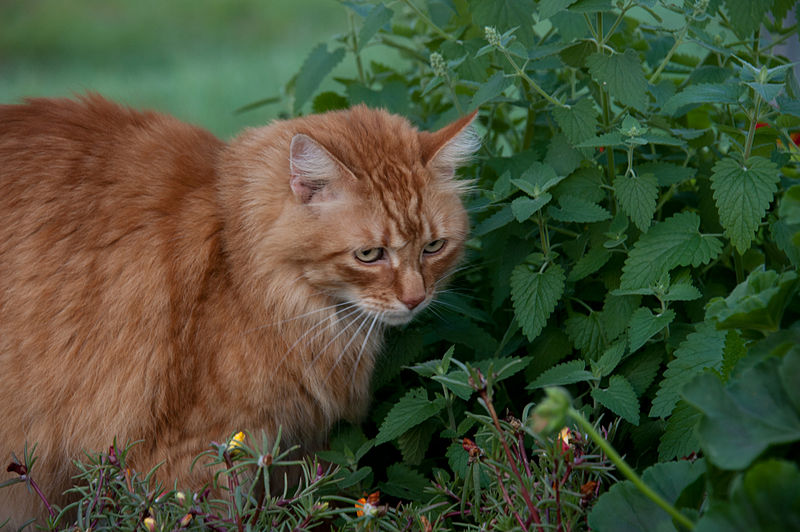Petowners love pampering their pets. What better way to pamper your cat than to plant an herb garden filled with plants that are both healthful and delightful for them?

Cat Grass
Cat Grass (Wheat Grass Dactylis glomerata) Most cat owners keep a pot of cat grass indoors for their cats. Cat grass contains valuable nutrients, especially folic acid which is used in the production of hemoglobin, a component of the blood which carries oxygen throughout the body. Cat grass also provides your pets with fiber which aids digestion and can help with hairballs. Cat grass can be grown outdoors in your cat garden. It is a form of wheat. Since grain is poisonous for cats, it’s best to prevent your cat grass from setting seed. Plant it in full sun and keep it trimmed below its maximum height of 5’. About 3 inches tall is ideal. Wheat grass is easy to grow from seed. Sow the seeds ¼” apart and ½” deep either indoors in a container or outdoors direct sown into your garden. Germination should occur in 7 days. It is ready for your felines when it reaches a height of 2” tall.
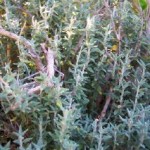
Cat Thyme
Cat Thyme (Teucrium marum) Cat thyme is not actually a thyme, although its leaves look like thyme leaves. It is related to germander. It has a strong musky odor which cats find irresistible. Rather than eating it, they love to roll around on it. Some cats even prefer it over catnip. Some people find the odor distasteful, so you might want to plant cat thyme a distance from your house. Cat thyme is an evergreen perennial hardy in zones 5 through 11. It grows in rounded mounds that can reach a height of 3’ to 4’ in ideal conditions. Most plants grow to about 1’. Plant it in full sun. It will not grow in shade. Like its relative, germander, it is drought tolerant. Cat thyme sports lovely pink flowers from July through September. Plants can be pruned and shaped after they have finished blooming. Cat thyme is most often grown from cuttings. If you wish to grow it from seed, the most common method is using a cold frame. Sow your seeds in a cold frame in the spring, barely covering them with soil. Seedlings can be transplanted into your garden after all danger of frost has passed. It’s a good idea to protect your plants from cats using a fence or other barrier until they have become established.

Catmint
Catmint (Nepeta x faassenii) Catmint is not a mint, although it is in the mint family. It is related to catnip and contains the same cat attracting chemical (nepetalactone) as catnip, but in lower concentrations. Cats find it just as appealing as catnip. Catmint is a herbaceous perennial hardy in zones 3 through 8. It is usually grown as an ornamental plant thanks to its fragrant foliage and sprays of blue flowers which appear in the spring. Plants should be cut back by about a third after flowering to neaten their appearance and encourage a second flush of flowers later in the summer. Depending on the variety, catmint can grow as tall as 3’ to 4’. It is drought tolerant. Like mints, it prefers full sun but will tolerate partial shade. Most catmints available produce sterile seed, so propagation is done by division. Plants should be divided every 3 to 4 years to keep them healthy.

Catnip
Catnip (Nepeta cataria) The classic cat herb, it contains the chemical nepetalactone, which drives cats crazy inducing a “high” which can last up to two hours. The attraction to the chemical is genetic. Only 80% of cats carry the gene. Cats without the gene are unaffected by both catnip and catmint so you might want to plant cat thyme instead. Catnip is a short-lived herbaceous perennial that is hardy on zones 3 through 9. It grows 2’ to 3’ tall and is drought tolerant. Like the mints to which it is related, catnip prefers full sun but will tolerate partial shade. It produces white or lavender flowers in the spring. You can extend the flowering season by removing the dead flowers before they set seed. Regular deadheading is recommended. Catnip is a prolific self-sower. It can be grown from either seeds or cuttings. You can start seeds indoors 8 weeks before your last frost. Barely cover the seeds and keep them moist but not wet. Germination should occur in 7 to 10 days. You can set your plants out in your garden after all danger of frost has passed.
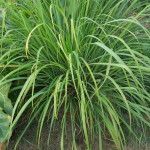
Lemongrass
Lemongrass (Cymbopogon citratus) Lemongrass might seem an unlikely herb for your cat garden but cats love its scent like we do. Lemon grass also aids in digestion like wheat grass (cat grass). Lemongrass is a tropical perennial that is hardy through zone 9. North of zone 9, it is grown either as an annual or brought indoors during the winter. It requires full sun. Mature plants reach 5’ in height. Plants should be divided every 3 to 4 years to keep them healthy. Lemongrass is easily grown from seed. Start the seed indoors 8 weeks before your last frost date. Transplant it outdoors after the last frost when the plants are at least 12 inches tall.
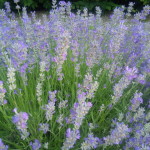
Lavender
Lavender (Lavandula spp) Lavender is a surprising addition to your cat garden. Cats find its scent as relaxing as we do. Lavender is a shrubby perennial that is drought tolerant and likes full sun. English lavenders are hardy to zone 5. The French and Spanish lavenders are only perennial through zone 8. Lavender is difficult to grow from seed. The resulting plants are highly variable. You can start your seeds indoors 8 to 10 weeks before your last frost date. Germination, which can be very spotty, should occur within 2 weeks. You can move your seedlings to your garden after all danger of frost.
Mint (Mentha spp) Mint might seem an unusual choice for a cat garden, but cats love to sniff it and rub in it. They will occasionally nibble at the leaves. Beware that too much peppermint can cause your pets digestive distress, so keep an eye on your cats around mint. Most mints are hardy perennials. Peppermint is hardy in zones 3 through 7 while spearmint is hardy is zones 4 to 11. Most mints grow from 12” to 24” in partial shade to full sun. All require moisture. The best way to kill mint is to allow it to dry out. Mints are best propagated by cuttings or division. They can be grown from seeds, but the results are highly variable. You may not get the mint you wanted. If you do want to grow mint from seed, you can start them outdoors after your last frost in a partially shady moist spot in your garden or indoors 8 to 10 weeks before your last frost date. Germination should be within 12 to 16 days. Your plants can be transplanted to your garden after all danger of frost. Please note that while mint leaves are edible, mint seeds are poisonous and should never be eaten.
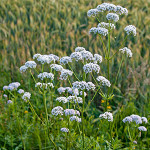
Valerian
Valerian (Valeriana officinalis) Similar to catnip, valerian act as a sedative for humans but as an attractant to cats. It contains the chemical actinidine which mimics the odor of cat urine. Valerian is a herbaceous perennial that is hardy in zones 4 through 8. Valerian loves full sun and rich soil. The plants usually grow 3’ to 4’ tall, but occasionally reach heights up to 5’ tall. The flowers vary from white through pink and appearing in late spring. The flowers smell like vanilla but the foliage, which contains the adtinidine, has a foul odor often described as smelling like unwashed feet. Valerian can be grown from seed. It will readily self-sow itself in your garden or you can direct sow the seeds in your garden when the soil temperature reaches 68⁰F or start your seeds indoors and plant the seedlings outdoors when the soil has warmed to 68⁰F. Surface sow your seeds. Do not cover them. They need sunlight to germinate. Press the seeds firmly on the soil to ensure good contact. The temperature of the soil is what tells the seeds when it’s time to germinate. Germination will occur within 1 to 2 weeks. You can transplant your seedlings into your garden after all danger of frost has passed.

